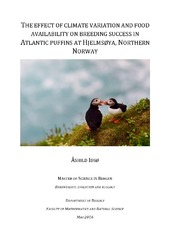| dc.contributor.author | Idsø, Åshild | |
| dc.date.accessioned | 2017-05-11T11:29:03Z | |
| dc.date.available | 2017-05-11T11:29:03Z | |
| dc.date.issued | 2016-05-27 | |
| dc.date.submitted | 2016-05-27 | eng |
| dc.identifier.uri | https://hdl.handle.net/1956/15803 | |
| dc.description.abstract | The colony of Atlantic puffins (Fratercula arctica) at Hjelmsøya, in Northern Norway has experienced extensive annual fluctuations in breeding success. To investigate how climate variability affects the population dynamics of this iconic seabird, I have analysed data on breeding success for this colony for the past 10 years. Through analysis of the time-series data I wished to investigate which climate and oceanographic conditions that best explained the variance in breeding success. My hypotheses were that 1) the short-time variation apparent in breeding success is best explained by climatic conditions in the months leading up to the breeding season, and that 2) this effect will be most apparent indirectly, through the availability of prey. Where earlier studies mainly consider the NAO index as a parameter for climate variability, I have included several other teleconnections to account for other modes of climate variability in the Northern Atlantic. The abundance of cod larvae in the Barents Sea was the single variable that explained most of the variance in breeding success, having a significant positive effect on breeding. I found that the effect of climate on breeding success for the puffin colony at Hjelsmøya was most apparent indirectly, through the availability of cod larvae in the Barents Sea, which had a significant positive effect on breeding success. While commonly used climate teleconnection patterns, such as NAO, could only weakly explain the variance in breeding success, the effect of NAO on abundance of cod larvae was considerably stronger. This supports the hypothesis that the effect of climate is most apparent indirectly, through the availability of prey. In addition, the multiple regression model explaining most of the variance was the model including NAO, cod larvae abundance and cod larval drift as covariates. Thus, the causal pathway by which climate seems to influence breeding success is by its effects on oceanic currents affecting larval drift and thereby the amount of fish larvae available to the puffins breeding at Hjelmsøya. | en_US |
| dc.description.abstract | Kolonien av lundefugl (Fratercula Arctica) på Hjelmsøya, i Nord-Norge har opplevd omfattende årlige svingninger i hekkesuksess. For å undersøke hvordan klimavariasjoner påvirker populasjonsdynamikk av denne ikoniske sjøfugl, har jeg analysert data på hekkesuksess for denne kolonien for de siste 10 årene. Gjennom analyse av tidsserier data ønsket jeg å undersøke hvilke klima og oseanografiske forhold som best forklarte variansen i hekkesuksess. Mine hypoteser var at 1) på kort tid variasjon tydelig i hekkesuksess er best forklart av klimatiske forholdene i månedene frem til hekkesesongen, og at 2) denne effekten vil være mest tydelig indirekte, gjennom tilgjengeligheten av byttedyr. Der tidligere studier hovedsakelig vurdere NAO-indeksen som en parameter for klimavariasjoner, har jeg tatt flere andre klimaindekser å ta hensyn til andre former for klimavariabilitet i Nord-Atlanteren. Mengden torskelarver i Barentshavet var den variabelen som forklarer mest av variasjonen i hekkesuksess, og hadde en betydelig positiv effekt på hekkesuksess. Jeg fant at effekten av klima på hekkesuksess for lundekolonien på Hjelsmøya var mest tydelig indirekte, gjennom tilgjengeligheten av torskelarver i Barentshavet, som hadde en signifikant positiv effekt på hekkesuksess. Mens vanlig brukte klimaindekser, som for eksempel NAO, ikke kunne forklare mye av variansen i hekkesuksess, var virkningen av NAO på mengden av torskelarver betydelig sterkere. Dette støtter hypotesen om at effekten av klimaet er mest tydelig indirekte, gjennom tilgjengeligheten av byttedyr. Den regresjonsmodellen med flere forklaringsvariabler som forklarte mest av variansen i hekkesukess var i tillegg den modellen som inkluderte både NAO, mengde torskelarver og larvedrift som kovariater. Dermed, den retningen klima synes å påvirke hekkesuksess er gjennom dens effekter på havstrømmer, og dens påvirkning på larvedrift og dermed mengden av fiskelarver tilgjengelig for lundefugl som hekker på Hjelmsøya | en_US |
| dc.format.extent | 1968363 bytes | eng |
| dc.format.mimetype | application/pdf | eng |
| dc.language.iso | eng | eng |
| dc.publisher | The University of Bergen | en_US |
| dc.subject | breeding success | eng |
| dc.subject | Atlantic puffin | eng |
| dc.subject | prey availability | eng |
| dc.subject | NAO | eng |
| dc.subject | larval drift | eng |
| dc.title | The effect of climate variation and food availability on breeding success in Atlantic puffins at Hjelmsøya, Northern Norway | en_US |
| dc.type | Master thesis | |
| dc.rights.holder | Copyright the Author. All rights reserved | en_US |
| dc.description.degree | Master i Biologi | en_US |
| dc.description.localcode | MAMN-BIO | |
| dc.description.localcode | BIO399 | |
| dc.subject.nus | 751999 | eng |
| fs.subjectcode | BIO399 | |
